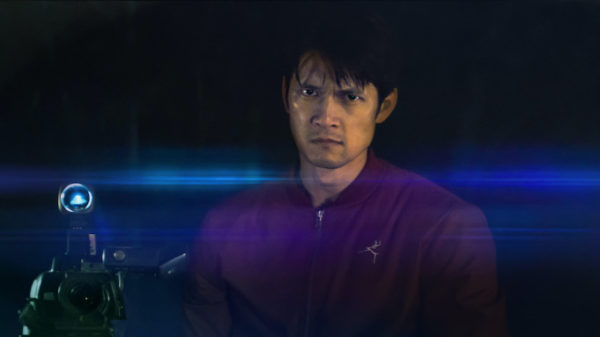
What happens when you combine technophobia, conspiracy theory and a dogged investigation into the seedy underbelly of society?
You get 90s throwback Broadcast Signal Intrusion.
Jacob Gentry’s film plays like an intriguing pastiche of the pirate signals from Videodrome crossed with the amateur gumshoe (and unreliable narrator) of Memento and other contemporary neo-noirs.
In the film, Harry Shum Jr plays James, a man who is grieving the loss of his wife Hannah. Aside from his Grief Anonymous group, James is isolated and withdrawn, even at his job as a VHS to DVD converter whose co-worker/boss L is only glimpsed in post-its.
One day James stumbles upon a blip in a tape featuring tall people (James Swanton) in uncanny masks accompanied by distorted audio. An investigation of the titular signal intrusion brings him to Dr. Stuart Lithgow (Steve Pringle) who cues him that other hacks exist and they may be tied to the disappearance of several women, including Hannah. Armed with scant facts, James’ obsession leads him into a murky underground world populated by questionable figures like James’ shadow Alice (Kelley Mack), shady Manager (Richard Cotovsky) and phone hacker Phreaker (Chris Sullivan).
Intriguingly the 90s time setting (and accompanying aesthetic) is less prevalent than the limitations of that decade’s technology, which doesn’t hamper James’ investigation as much as it drives the narrative in certain directions. Beyond the confines of James’ paranoia, which is evidenced by his distrust of home landlines, the primitive 90s technology means that the Internet is present exclusively in the form of chat rooms and server browsers. As a result James is frequently required to venture out of his self-imposed isolation and into dangerous real life situations.
This helps to ensure that Broadcast Signal Intrusion isn’t geographically restricted to dank, dimly lit environments (though there are several of those). It also guarantees more of the kind of clandestine meetings with shadowy figures that audiences expect from mystery films; James must venture into uncomfortable and threatening environments such as seedy church basements, underground parking lots, back alleys, underpasses and derelict houses. The visual aesthetic is suitably grimy and dirty, with particular attention paid to the set design, which has a lived-in messiness that rings authentic.
This messy, dirtiness is when Broadcast Signal Intrusion is at its best. The film delights in capturing weird, uncomfortable moments, such as the truly unsettling imagery of the Sal-E Sparks pirate tapes. The uncanny nature of the android/face masks, as well as their height and size in proximity to their surroundings is fantastically creepy and effective. The look, combined with the audio distortion, the DIY 90s video tape visuals, and the brevity of the tapes, is so compelling that it’s not hard to understand why James all but destroys his life in pursuit of them.
Aside from the pirate videos themselves, there are two stand-out sequences. One involves a tense confrontation in a dimly lit basement as increasingly loud, hurried footsteps echo above. The other is the final confrontation with the purported person behind the tapes at an abandoned house. Both of these sequences offer both closure and simultaneously answer nothing. The result will undoubtedly be divisive, but as stand-alone sequences designed to generate sustained tension and atmosphere, they’re excellent.
The issue with Broadcast Signal Intrusion is less the mise-en-scene than the mystery and the characters themselves. Despite a familiar backstory loaded with grief, James never truly becomes a character in his own right. Shum Jr is completely competent as an anchor for the film and James’ slow unraveling as he pushes himself to the brink of insanity in the pursuit of “the truth” is compelling, but the character isn’t fully realized. James has a background and motivation, but he’s less of a character than he is a plot construct.
That’s because Gentry’s script is only interested in James as a cypher: a driver to move the plot from location to location and collect random scraps of info that don’t so much illuminate the mystery as keep it barreling forward. There comes a point where Broadcast Signal Intrusion’s innumerable details cease to become important; the clues, and even the larger mystery, is simply a McGuffin.
Therein lies the grift: attentive audiences looking to solve the riddle along with James will walk away disappointed because Broadcast Signal Intrusion is uninterested in simple truths or answers. This is a film dedicated wholly to the journey, not the outcome. In this capacity the repeated warnings that multiple characters deliver, suggesting that James’ pursuit will consume him, is also a warning to audiences.
To watch and invest yourself in Broadcast Signal Intrusion’s mystery is an act of submission: embarking on this simultaneously underwhelming (in its resolution) and overwhelming (in its sheer, endless drive) journey will leave audiences as disoriented and exhausted as its protagonist.
3/5